Learn about the American dime history and identify the different kinds of silver dimes, such as the Roosevelt dime, Barber dime, Seated Liberty dime, etc.
The term dime comes from a French word “di(s)me”, meaning “tithe” or “tenth part. The dime is a coin worth ten cents or one tenth of a United States dollar.
The dime was commissioned by the Coinage Act of 1792 and production began in 1796. A feminine head representing Liberty was used in front of the dime and an eagle was used on the back.
Silver dime’s design history
Since 1796, silver dimes were issued in six major types. The name of each coin indicates the design on the obverse, except Barber dime.
• Draped bust/small eagle silver dimes (1796-1797)
• Draped bust/large eagle silver dimes (1798-1807)
• Capped bust silver dimes (1809-1837)
• Seated Liberty silver dimes (1837-1891).
• Barber silver dimes (1892-1916)
• Mercury silver dimes (1916-1945).
• Roosevelt silver dimes (1946-present)
From 1796 to 1837, silver dimes were composed of 89.24 percent silver and 10.76 percent copper. The composition was changed in 1837 when the Seated Liberty dime was introduced. The silver content was increased to 90 percent while the copper content was reduced to 10 percent.
To maintain the intrinsic value of the new silver dime the diameter was reduced from 18.8 millimeters (0.740 inch) to 17.9 millimeters ((0.705 inch).
In 1965, the composition of silver dimes was changed. The Coinage Act of 1965 removed the silver content of the silver dime and replaced it with a clad composition of 75 percent copper and 25 percent nickel.
In the same year, hoarding of silver coins was unstoppable. Collectors lost their interest in investing coins for their numismatic value because most people are interested in selling nickels and dimes due to the silver coin melt value.
Draped bust dime (1796-1807)

In 1796, the Draped bust/Small eagle dime was the first dime circulated. The obverse depicts the portrait of lady Liberty. The portrait was based on a Gilbert Stuart drawing of a prominent Philadelphia socialite Ann Willing Bingham, wife of American state man William Bingham.
As designed by Robert Scott, the reverse of the Draped bust dime features the image of a small bald eagle perching on the clouds. Surrounding the eagle are palm and olive branches.
All 1796 dimes have 15 stars representing the number of States in the Union. The following year, dimes were minted with 16 stars reflecting the Tennesse’s admission as the 16th State.
However, United States Mint director Elias Boudinot ordered a design alteration featuring just thirteen stars – for the thirteen original colonies. Therefore, 1797 Draped bust silver dimes have either 13 or 16 stars.
The Draped bust/Heraldic eagle silver dime first appeared in the public in 1798. The obverse side of the coin has the same feature to the small eagle dime.
But the reverse was changed from a scrawny eagle to a scaled-down version of the great seal of United States. Both the Small eagle silver dime and Heraldic eagle silver dime were designed by Robert Scott.
Capped bust silver dime (1809-1837)
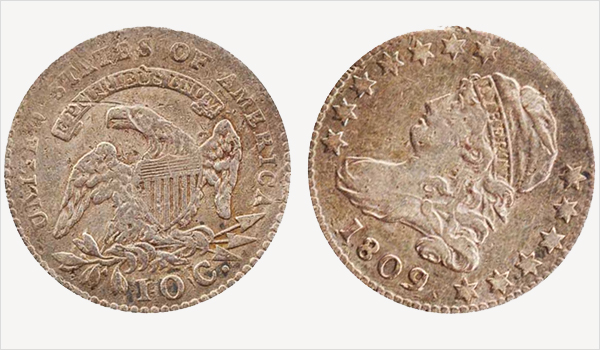
The Draped bust silver dime was succeeded by the Capped bust dime in 1809. Both sides of the coin were changed by the mint assistant engraver John Reich. The reverse of the coin features a bald eagle holding three arrows symbolizing strength and an olive branch symbolizing peace.
The United States shield with six horizontal lines and thirteen vertical stripes covers the breast of the eagle. A “10C” is also inscribed on the reverse indicating the value of the coin. The Capped bust dime is the only dime minted with an explicit indication of its value.
Capped bust silver dimes minted until 1828 are known as large type. Large type silver dimes were struck without a restraining collar, which gave them a broader appearance. In the same year, chief engraver William Kneass introduced a new method of standardizing the diameter of the coin, a restraining collar.
A restraining collar keeps the coin from spreading. The new method allowed the United States Mint to produce thicker coins. To maintain the standard weight of the silver dime, the diameter was reduced from 18.8 mm to 18.5 mm. The new Capped bust dime is now called small type.
Seated Liberty dime (1837-1891)
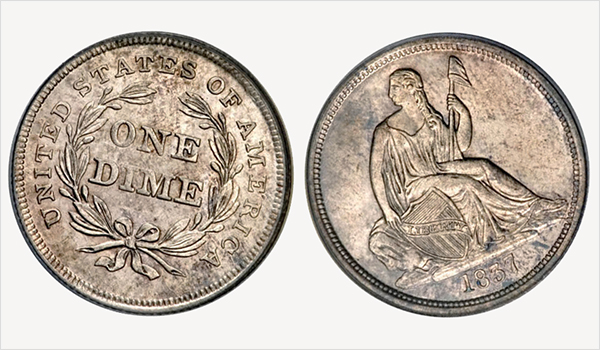
The Seated Liberty dime is a ten cent coin that was produced from 1837 to 1891. Chief engraver William Kneass drew sketches of the coin but suffered a stroke and was too ill to finish the design. Christian Gobrecht, who was promoted to second engraver, completed the design of the coin.
The obverse of the coin features the image of lady Liberty sitting on a rock. She is wearing a dress and holding a staff with a cap on top. Her right hand is balancing a shield with an inscribed word “LIBERTY”. On the reverse is a wreath surrounding the words “ONE DIME”.
There are several varieties of Seated Liberty dime.
• No stars on obverse (1837-1838)
• Stars on obverse (1838-1853)
• No drapery from elbow (1838-1840)
• Arrows at Date (1853-1855)
• Legend on Obverse (1860-1873
• Arrows at Date (1873-1874)
Barber dime (1892-1916)

The Barber dime is a United States dime produced from 1892 to 1916. The silver Barber dime was named after Charles E. Barber who was the chief engraver of the United States Mint from 1879 to 1917.
The obverse of Barber dime depicts the head of lady Liberty. She is wearing a phrygian cap, a laurel wreath with a ribbon and a headband with the inscribed word “LIBERTY”.
The reverse of the Barber silver dime has the words “ONE DIME” surrounded by a wreath which is almost identical to the reverse of the Seated Liberty Dime.
Winged liberty head dime (1916-1945)
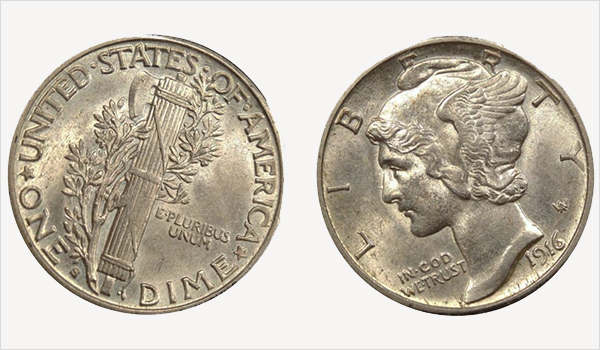
The Winged liberty dime is also known as Mercury dime. The Mercury dime is considered one of the most beautiful United States coin designs ever produced.
The reverse of the coin features fasces juxtaposed with an olive branch. It symbolizes America’s readiness for war and strong desire for peace. Adolph A. Weiman designed the reverse of the coin.
Weiman added wings to the phrygian cap that symbolize liberty of thought. These wings were quickly associated with the Roman god, Mercury. Thus, coin became known as the Mercury Dime.
The composition (90 percent silver and 10 percent copper) and diameter (17.9 millimeters) of the Mercury dime was unchanged from Barber dimes.
Roosevelt silver dime (1946-present)
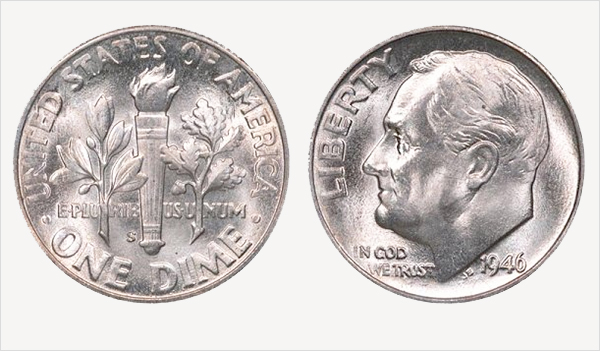
The Roosevelt Dime is a United States dime that was first produced in 1946, shortly after the death of the nation’s 32nd President. The dime was chosen to honor President Franklin D. Roosevelt due to his efforts in founding the National Foundation for Infantile Paralysis (known as March of Dimes).
During Roosevelt’s 64th birthday, January 30, 1946, the dime was released to the public. Chief engraver John R. Sinnock designed the Roosevelt dime.
The obverse of the coin features the bust of Roosevelt, with the inscription “LIBERTY” and “IN GOD WE TRUST”. The design elements for the reverse include a torch symbolizing liberty, an olive branch symbolizing peace, and an oak branch symbolizing victory.
A controversy was rumored when Roosevelt dimes were released in the circulation. An Anti-communist said that the “JS” engraved on the coin was the initials of Joseph Stalin, the General Secretary of the Communist Party of the Soviet Union’s Central Committee. The United States Mint quickly confirmed that the initial JS were John R. Sinnock.
Another controversy arose when Selma Burke claimed that John R. Sinnock borrowed Burke’s design. Sinnock denied and claimed that he simply utilized his earlier design on the Roosevelt medal.
With the passage of the Coinage Act of 1965, the composition of the Roosevelt dime was changed from 90 percent silver and 10 percent copper to a clad composition of 75 percent copper and 25 percent nickel. Coins that were minted either in 1965 and 1966 bear the date 1964.
Soon after the change of composition, silver dimes began to disappear from the circulation, as well as quarter and half dollar. These disappearing silver coins were referred as junk silver coins.
The following are the rarities of the Roosevelt dimes:
• Key dates (rare coins) – 1949-S
• Semi-key dates (close to rare coins) – 1949, 1950-S, 1951-S, 1952-S
The following are the error Roosevelt dimes:
• Doubled-die obverse – 1960
• Doubled-die reverse – 1963, 1964-D
• Proof coins that were made without the ‘S’ mintmark – 1968, 1970, 1975, 1983
• 1982 no mintmark error dime – minted in Philadelphia but without ‘P’ mintmark, less than 15,000 are believed to exist






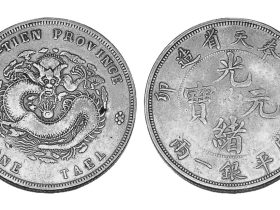
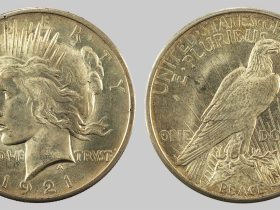
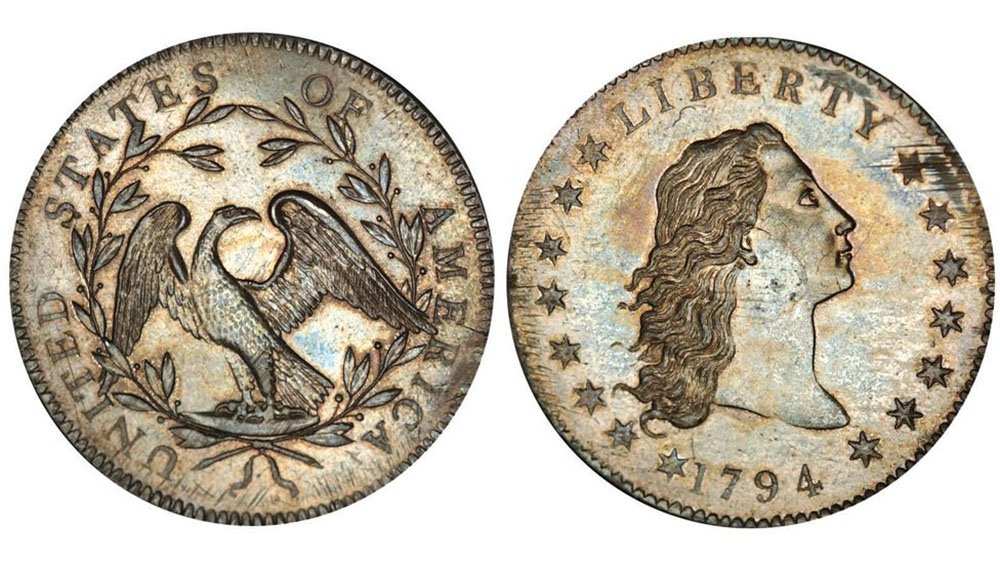


Leave a Reply